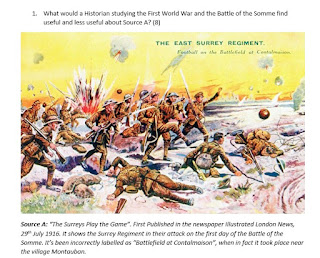Integrating LGBTQ+ into the classroom
I have been thinking about this for a while - inspired by Christine Counsel's ideas of curriculum development I explore elsewhere, as well as by a recent webinar I attended on "How to do LGBTQ History" which I thought was fascinating. I am currently reading this excellent book which addresses some of the current thinking in the historiography and in particular the key problem of terminology.
In an era where the boundaries are being explored and where identity (both outward and inward) is important, the use of terms like "gay", "bisexual" and even "queer" become problematic. Individuals in the past may not recognise the terms historians and others use when discussing LGBTQ issues in the past. I first came across "queer" as a child in the 1980s when it was being used as a term of abuse, but it has reclaimed as a broad label for identities, or as this article by the National Archives says it is "a label that encompasses the fluidity of identity, or the lack of alternative suitable terminology". It is in this manner I use it cautiously.
All of which is a way of framing my own explorations of how to integrate LGBTQ history into the classroom. The take-away from the webinar was that it should be integrated where possible - as to do so gives students a more full explanation of history (so we are not "silencing the past" as Michel-Rolph Trouillot put it).
Like many in the webinar I have engaged with the experience of gay men and women in Weimar Germany by focusing on the story of the "Eldorado club" - I explore how the club changes over time including being a spot Ernst Rohm frequents, and eventually how it ends up as a regional office of the SA.
When I get to it next year I intend to explore the gay community in Weimar Germany more fully as I am conscious that while there is a limited timeframe for me to address this story in the context of an IGCSE Depth Study, I didn't explore how dangerous the club was and what the threat to gay men and women's very existence was even before the Nazi era. Although this is a topic very unlikely to be asked in a GCSE question, it does give students a more full knowledge of the era and also does help to demonstrate that there is an LGBTQ history out there, even if it is not usually examined by educationalists outside a university course.
I have been wondering where would be a sensible place within the KS3 curriculum to integrate "queer" history; there may be an opportunity within the study of the French Revolution (perhaps addressing the misogyny against Marie-Antoinette?), and I am hoping that there may be room in the Industrial Revolution to examine some of the laws (where for example consenting gay men were imprisoned), or even the opportunities for more wealthy individuals in a more mobile society to be themselves (for example Anne Lister).
That is for later this term - however I was pleased I managed to address some aspect of this in a study of attitudes to war in the Home Front of World War One. Although the focus of the lesson was on how Conscientious Objectors were viewed and whether this was actually the truth, the case-study of Sassoon was useful for a number of reasons. One of which was made by students where they made the link between the unpleasant caricature of the conchie in the cartoon compared to Sassoon's experience in war as a war-hero who has a crisis of conscience:
I felt it was important given the cartoon to give students the additional information that Sassoon and Owen loved each-other, as this was a useful contrast to the cartoon conchie. Sassoon's identity as a gay man, a term he may not have appreciated in the way we do today, is not necessarily critical to appreciating him as a Conscientious Objector, but it does give a more full understanding of him as a human and deepens student appreciation of the era.
Very few students vocalised the contrast that could be drawn between the cartoon and the relationship of Sassoon and Owen in the context of their war experience. However, I hope that integrating this little bit of LGBTQ+ history into a "regular" history lesson normalises the history of "queer" in the curriculum.







Comments
Post a Comment